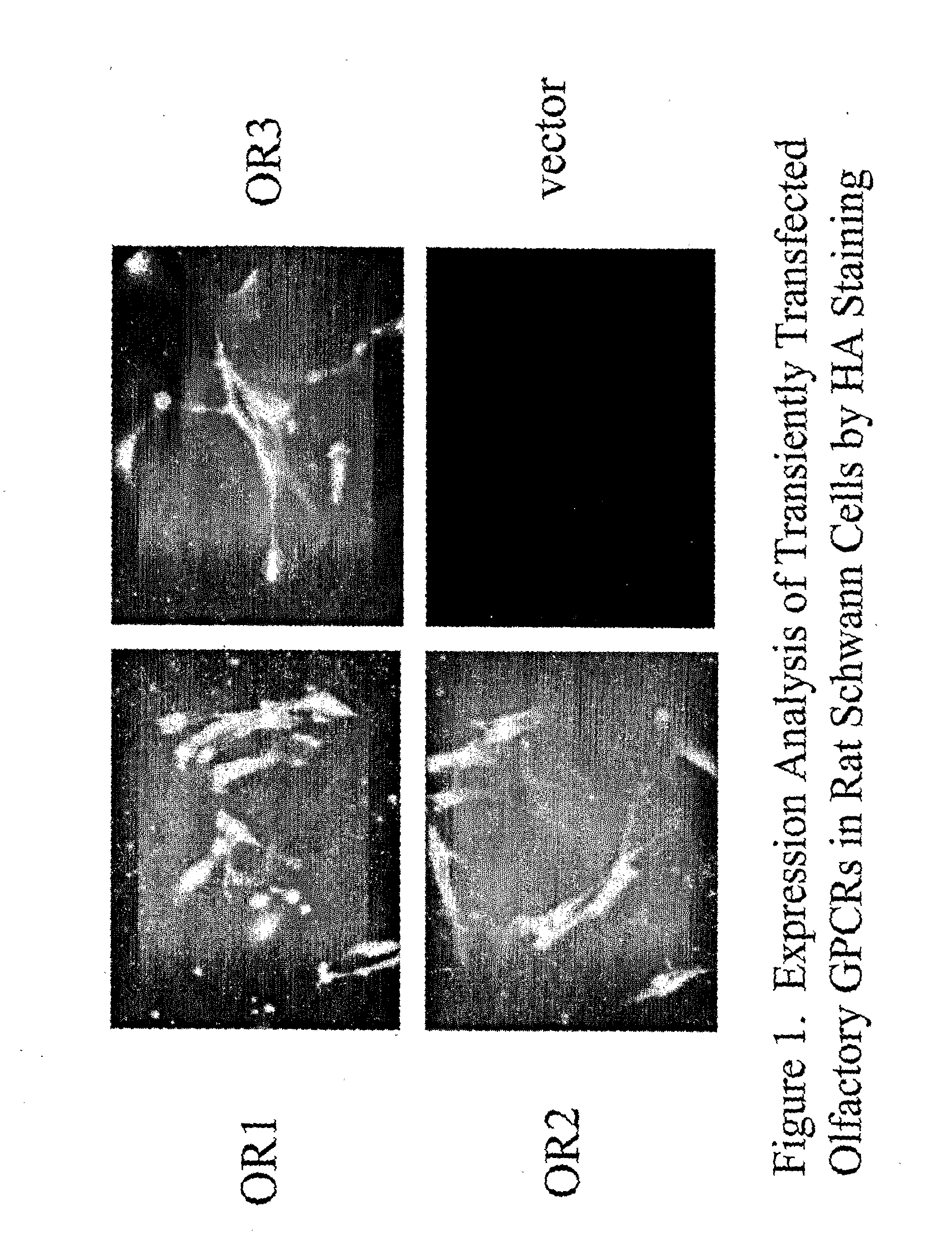Methods for producing olfactory gpcrs
a technology of olfactory gpcrs and gpcr proteins, which is applied in the field of methods for producing olfactory gpcr proteins, can solve the problems of a robust, reliable and efficient method for producing and assaying gpcrs, affecting the progress of understanding odor perception and discrimination, and unable to express olfactory gpcrs
- Summary
- Abstract
- Description
- Claims
- Application Information
AI Technical Summary
Benefits of technology
Problems solved by technology
Method used
Image
Examples
example 1
Expression of Olfactory GPCRs in Schwann Cells
[0150]Primary Rat Schwann Cell Isolation:
[0151]The preparation of Schwann cells was done as described previously (e.g., Hung, Int. J. Oncol. 20:475-82, 2002; Hung, Int. J. Oncol. 1999 14:409-15; Wood, Brain Res. 115:361-75, 1976; Wood, Ann. N.Y. Acad. Sci. 605:1-14, 1990; and Brockes, J. Exp. Biol. December; 95:215-30, 1981, etc). Briefly, sciatic nerves from P1 rat neonates were harvested and cells were maintained in Dulbecco's modified Eagle media supplemented with 10% heat-inactivated fetal bovine serum. Schwann cells were expanded with 2 uM forskolin and bovine pituitary extract (Sigma). The cells were grown until the third passage and frozen for storage.
[0152]Transient Transfection of Olfactory GPCRs:
[0153]Schwann cells at passage 5 were plated on poly-D-lysine coated 8-well chamber slides (Falcon) at 8×104 cells per well. The Schwann cells were transfected with 0.5 ug of olfactory GPCR expression plasmid with Fugene6 reagent (Roche...
example 2
GPCR Activation Assays
[0157]Receptor Expression: Transient transfection of macroglial cells may be carried out as described in Example 1 for primary rat Schwann cells. Stable transfection of a macroglial cell line may be carried out as described here.
[0158]Approximately 12×106 macroglial cells are plated on a 15 cm tissue culture plate and grown in DME High Glucose Medium containing ten percent fetal bovine serum and one percent sodium pyruvate, L-glutamine, and antibiotics. Twenty-four hours following plating of the macroglial cells (or to ˜80% confluency), the cells are transfected using 12 μg of DNA. The 12 μg of DNA is combined with 60 μl of lipofectamine and 2 mL of DME High Glucose Medium without serum. The medium is aspirated from the plates and the cells are washed once with medium without serum. The DNA, lipofectamine, and medium mixture are added to the plate along with 10 ml of medium without serum. Following incubation at 37 degrees Celsius for four to five hours, the me...
PUM
| Property | Measurement | Unit |
|---|---|---|
| concentration | aaaaa | aaaaa |
| pH | aaaaa | aaaaa |
| volume | aaaaa | aaaaa |
Abstract
Description
Claims
Application Information
 Login to View More
Login to View More - R&D
- Intellectual Property
- Life Sciences
- Materials
- Tech Scout
- Unparalleled Data Quality
- Higher Quality Content
- 60% Fewer Hallucinations
Browse by: Latest US Patents, China's latest patents, Technical Efficacy Thesaurus, Application Domain, Technology Topic, Popular Technical Reports.
© 2025 PatSnap. All rights reserved.Legal|Privacy policy|Modern Slavery Act Transparency Statement|Sitemap|About US| Contact US: help@patsnap.com

